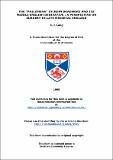Files in this item
The "Philomena" of John Bradmore and its Middle English derivative : a perspective on surgery in Late Medieval England
Item metadata
| dc.contributor.advisor | Macdougall, Simone C. | |
| dc.contributor.author | Lang, Sheila J. | |
| dc.coverage.spatial | 232 | en_US |
| dc.date.accessioned | 2014-06-25T14:50:57Z | |
| dc.date.available | 2014-06-25T14:50:57Z | |
| dc.date.issued | 1998 | |
| dc.identifier | uk.bl.ethos.600511 | |
| dc.identifier.uri | https://hdl.handle.net/10023/4910 | |
| dc.description.abstract | This thesis is a study of two related surgical texts produced in England in the fifteenth century. The Latin treatise entitled Philomena, British Library MS. Sloane 2272, was compiled by a London surgeon, John Bradmore, who died in 1412. British Library MS. Harley 1736 contains a Middle English version of part of Bradmore's treatise on ff.2-167. The relationship of the texts is discussed in the Introduction. Bradmore's authorship of the Latin text is established, and the mistaken attribution of the Middle English text, to surgeon Thomas Morstede, is refuted. Details of Bradmore's life, status, wealth, and associates, are given in Chapter 1. Chapters 2-3 concentrate on the form of Bradmore's Latin text, and his intentions and methods as its compiler. The manuscript is described, and is shown to be Bradmore's holograph. Many of the earlier authorities used by Bradmore as sources are identified, and his adaptation of them discussed. Chapter 4 gives a detailed study of cases Bradmore describes, drawn from his own experience, and attempts to show the rational basis for his treatments. These cases, though few in number, demonstrate the wide social range of Bradmore's patients, and the variety of conditions treated, with techniques and applications sometimes of Bradmore's own devising. Chapters 5-6 describe the Middle English version of Bradmore's work, and show that it is an adaptation as much as a translation of the Latin text. The intentions of the author are considered in order to assess his selectivity and to understand how the nature of his text differs from that of the Latin original. Bradmore's Latin text and its Middle English derivative offer a fascinating insight into the practice of surgery in the fifteenth century. Furthermore, the existence of Philomena in Bradmore's holograph provides a unique opportunity to see a compiler at work on his text. | en_US |
| dc.language.iso | en | en_US |
| dc.publisher | University of St Andrews | |
| dc.rights | Creative Commons Attribution-NonCommercial-NoDerivatives 4.0 International | |
| dc.rights.uri | http://creativecommons.org/licenses/by-nc-nd/4.0/ | |
| dc.title | The "Philomena" of John Bradmore and its Middle English derivative : a perspective on surgery in Late Medieval England | en_US |
| dc.type | Thesis | en_US |
| dc.type.qualificationlevel | Doctoral | en_US |
| dc.type.qualificationname | PhD Doctor of Philosophy | en_US |
| dc.publisher.institution | The University of St Andrews | en_US |
This item appears in the following Collection(s)
Except where otherwise noted within the work, this item's licence for re-use is described as Creative Commons Attribution-NonCommercial-NoDerivatives 4.0 International
Items in the St Andrews Research Repository are protected by copyright, with all rights reserved, unless otherwise indicated.


